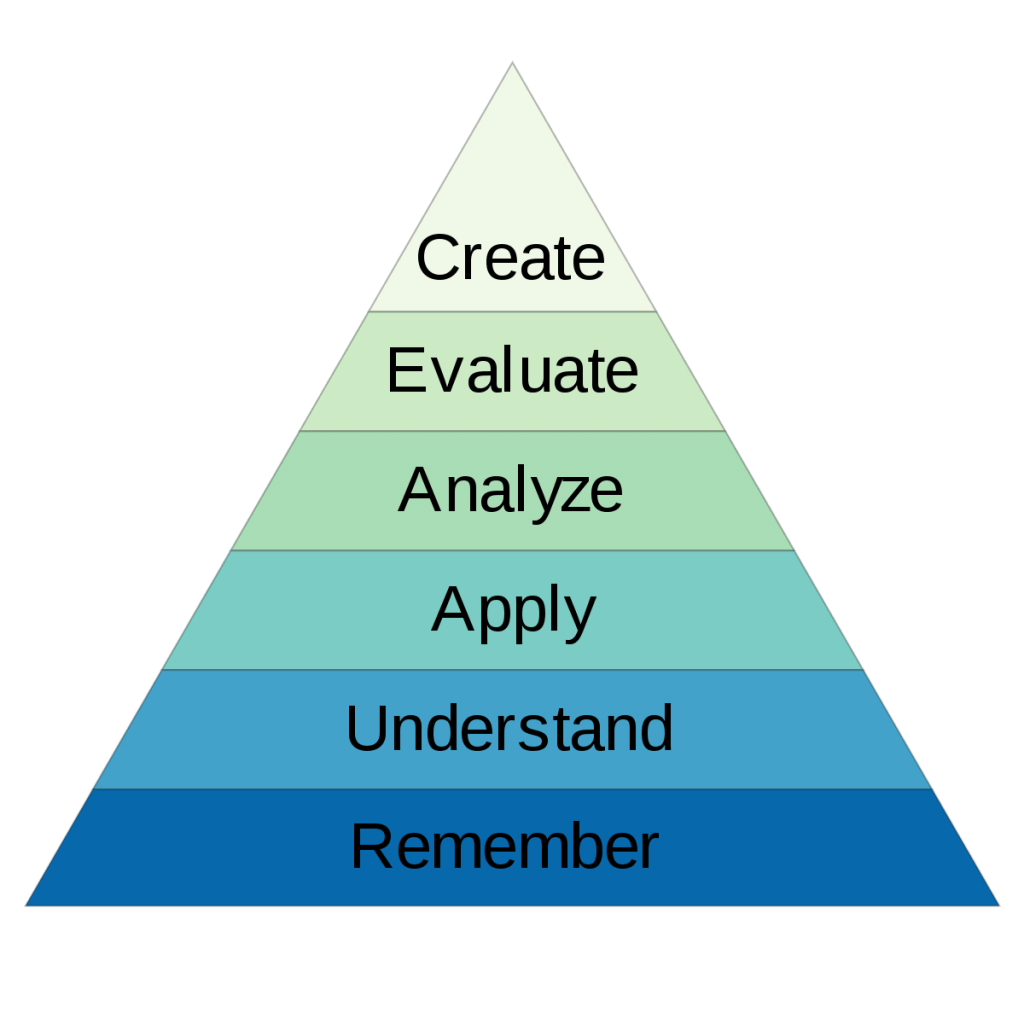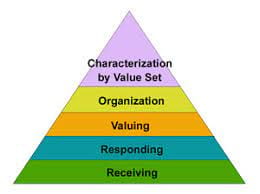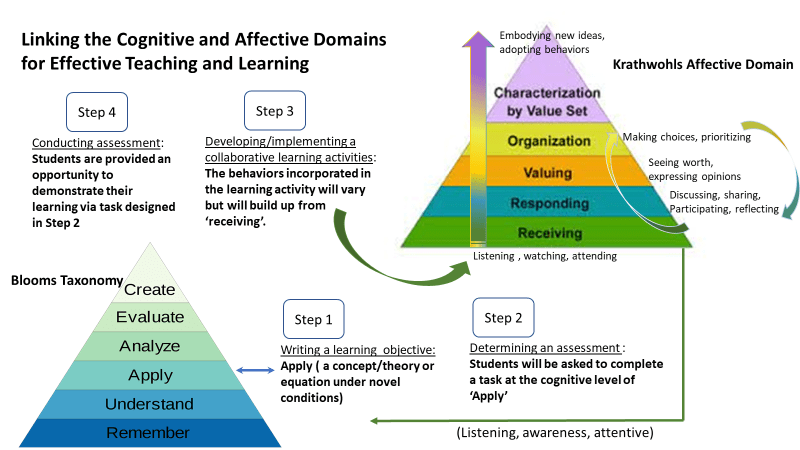
The Cognitive Domain – Learning as a hierarchy of increasingly difficult cognitive work
Educators use Bloom’s Taxonomy to think about and scaffold the degree of cognitive difficulty in courses and for helping to design activities and assignments appropriate to learning expectations. Cognitive challenge increases as we move ‘up’ the pyramid from ‘remember’ toward the pinnacle of cognitive complexity – ‘create’. Bloom’s taxonomy verb choices help teachers to write learning outcomes objectives at appropriate cognitive levels so that they can be sure they are facilitating learning in which the outcomes match the complexity of the objectives. As a reminder, here is one iteration of the classic but updated Blooms Triangle (with ‘create’ at the highest cognitive level):

A learning objective on the lowest rung of the taxonomy – the ‘remember’ level – might read: “by the end of this activity/class session the student will be able to define the 1st law of thermodynamics“. If the objective were to be at a higher cognitive level – the ‘apply’ level – the learning objective might read: “by the end of this activity/class session the student will be able to explain how the first law of thermodynamics applies to changes in a system when heat and pressure are applied”
In either case, the instructor can then design assessments at the level of the stated expectation and ‘backwards design’ appropriate activities or assignments to prepare students to be successful when they come to the assessment.
Bloom’s taxonomy has been through some iterative changes but, effectively, it’s been a really important framework for cognitive outcomes since the 1950s. This organization and development of critical thought processes (or cognitive difficulty) can guide curriculum development and learning tasks for students working with concepts and processes as they build deeper and more integrated knowledge.
The Affective Domain – Learning as a hierarchy of increasingly complex behaviors
Blooms Taxonomy has a critical parallel: Krathwohl’s Affective Domain. Discussions of the affective domain in teaching and learning are less common than the cognitive domain. This is at least true for STEM learning in higher education. Although Bloom still gets a lot of the credit for this ‘sister taxonomy’, the general consensus is that David Krathwohl, a close colleague who also worked on the cognitive domain, is the primary author and developer of the affective domain. Read a good review of both domains and the history of their evolution and authorship here.

This is the domain in which listening, acknowledging, reflecting, and decision making, using information gleaned at levels in the cognitive domain, can result in value development and perhaps even behavioral shifts. This is the domain in which learning is contextualized or situated. While we focus on the cognitive Bloom’s taxonomy for learning objectives and disciplinary structuring, learning is a social and reflective endeavor and the key to helping learning happen is in the affective domain: receiving, responding, valuing, organizing and ultimately characterizing that information are what lead to deep learning and real change. The cognitive domain describes the development of knowledge through acquiring and manipulating information, and the affective domain describes how knowledge is integrated into the learners’ frame of reference and in a social context. If we explicitly understand both the cognitive domain and the affective domain, and their intersection, we can be intentional about how we use them together to intensify the benefits for learners.
Powerful Learning explicitly applies both domains through collaborative learning
Since the initial development of these taxonomies (maybe before), an irrefutable consensus has been building in the teaching and learning literature: structuring collaborative learning activities within inclusive and reflective learning environments results in better learning objectives outcomes.

Regardless of the cognitive level of the learning outcome, awareness of and attention to (affective domain) the point at which students are entering into the knowledge arena should be a primary consideration. Once learning outcomes objectives are written (step 1), the teacher imagines a matching assessment that would provide information about how well the objective was achieved – did students learn what was intended (step 2)? Designing learning activities moves the teacher and student more directly into the affective domain (step 3). This is all about structuring the emotional and cognitive engagement cycle (see our earlier blog for review of cognitive and emotional engagement) through which students receive the information, consider it, discuss it, use it, value it, and make choices about where it fits in their cognitive/emotional map. For short activities, design might include a more linear pathway of activities. For example: groups of students may work independently to master an aspect of a topic or approach to a problem (receiving), and then teach each other the specific piece with which they worked (receiving and responding). The group may then discuss and put together the components, discuss its value and apply it to a related problem (valuing, organizing). In a long-term project (design development or other task) the work in the affective domain is likely to be cyclical and iterative. As ideas are built, discussed and valued, a new cycle of receiving and responding (reflection) that deepens the learning, improves the project and motivates students would be natural, but should be structured. Developing and sharing specific learning objectives with students, and structuring collaborative and inclusive learning activities have been shown to improve outcomes. These two Domains of learning are not new, and explicitly linking them is simply a reminder to check the pieces of our practice. Ultimately, when learners situate the new disciplinary knowledge into their social-emotional frameworks, long-term learning and real student growth are the outcomes.